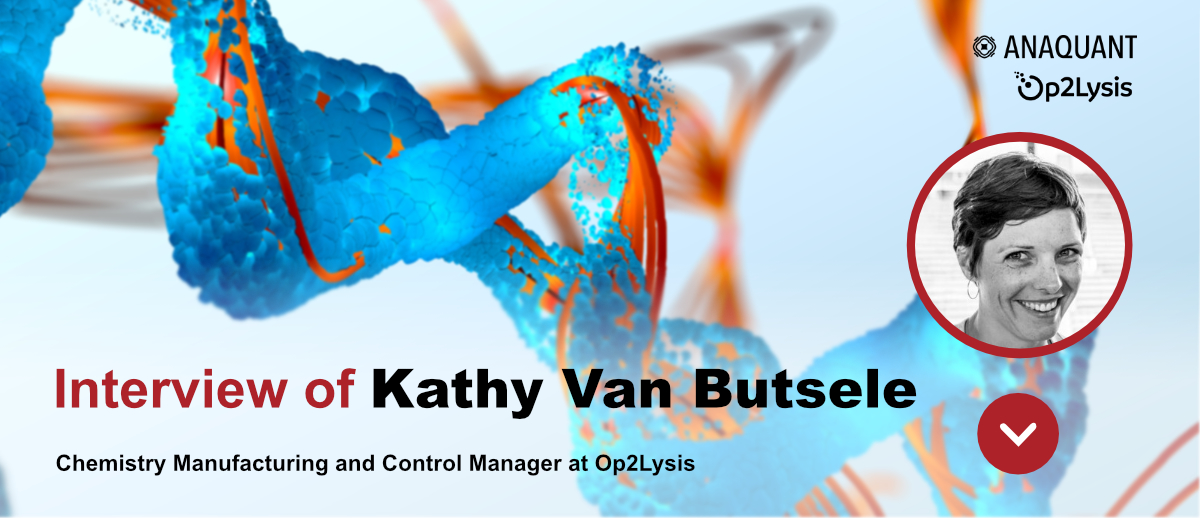
Founded in 2016, Op2Lysis is a biotechnology company focused on developing innovative treatments for hemorrhagic stroke patients. The company has developed a technology to remove the compressive hematoma that has formed following intracerebral hemorrhage, without damaging healthy brain cells.
Discover through the interview of Kathy Van Butsele, CMC Manager, Anaquant’s collaboration with Op2Lysis.
What does Op2Lysis do?
Op2Lysis is a six-person biotechnology company specializing in the therapeutic development of solutions for cerebrovascular thrombotic diseases.
A hemorrhagic stroke occurs following the rupture of a blood vessel in the brain. The flow of blood out of the vessel causes the formation of a hematoma, which is compressive and can have consequences ranging from disability to death of the patient. The challenge for doctors is to eliminate this hematoma.
To address this problem, we have developed an innovative new thrombolytic agent: O2L-001, a suspension of solid particles of OptPA, a new biological entity specifically tailored to destroy blood clots and hematoma in the neurovascular unit. The goal is to inject this agent directly into the heart of the solidified hematoma. The action of O2L-001 is then to liquefy the blood so that it can be removed from the patient’s brain by passive drainage.
What are your challenges with the development of this product?
Daily, we are challenged on three major axes.
· Cerebral route of administration
The intracerebral administration is an atypical drug delivery route. The published resources on which to rely for development are minimal. This is why we engaged discussions very early with health
agencies in the USA and in Europe to consolidate our development plan and to de-risk our business.
· Drug’s design
The OptPA substance is contained in the injectable end drug product O2L-001. This drug product is a liquid that gell with the temperature of the brain. This global design of O2L-001 allows for extended-release of OptPA in the hematoma to increase efficacy, safety and ease of use. This property of changing the condition of the product according to temperature is a development challenge that we have already met during industrial scale up.
· Thrombolytic agent
The OptPA substance is a recombinant protein. When you talk about a biological agent, you need to have a good knowledge of it and you need to have control over your manufacturing process. We must therefore be vigilant and precise during the development phases.
What is your job at Op2Lysis?
I am CMC (Chemistry Manufacturing and Control) Manager. I am responsible for the control of both our active substance and our finished product.
The goal of my work is to have manufacturing processes, both active substance and finished product, that are industrialized, reproducible and tested by quality controls. I follow the work of our subcontractors, to whom we delegate both manufacturing processes and quality control tests.
How do you collaborate with Anaquant?
Anaquant is a service provider that helps us control our manufacturing processes, especially in the development of our process.
Our recombinant protein, once produced, must be purified to remove residues from its production, including Host Cell Proteins (HCPs). Purification is done employing resins: depending on their properties, they retain different types of impurities. To select the resin to obtain the purest possible final protein, we conducted experiments with different types of resins under different conditions. The samples were sent to Anaquant, who did a series of residual HCP tests for us.
What method did they use to analyze your samples?
The advantage of the work performed by Anaquant is the precision of the results thanks to the combination of our ELISA results with their Mass Spectrometry analysis.
Process: our CMO (Contract Manufacturing Organisation) performs the ELISA analysis after it has produced our drugs. We then send these samples to Anaquant who provides more precision with mass spectrometry.
While ELISA allows us to obtain only the total amount of HCPs, MS allows us to accurately identify HCPs. Therefore thanks to the MS, we saw that the quantities corresponded to the presence of several residual elements.
Finally, these results allowed us to decide to combine some resins to have the lowest level of impurities.
Where are you in the development of this drug?
Our next step is the safety study of O2L-001 which must start by the end of 2023. This step serves to demonstrate that the safety of the product developed in the range of concentrations used in patients. The first phases of patient studies could take place in the second half of 2024.
For further reading: HCP analysis: ELISA or Mass Spectrometry.
 Anaquant HCP analysis I Protein characterisation I Protein analysis
Anaquant HCP analysis I Protein characterisation I Protein analysis